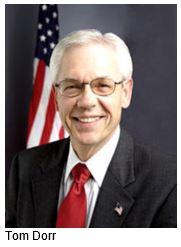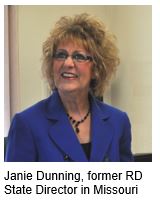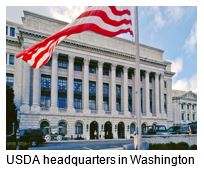WASHINGTON, May 17, 2017 - Agriculture Secretary Sonny Perdue’s plan to eliminate USDA’s office of undersecretary for rural development (RD) – currently reporting directly to the Secretary of Agriculture - could leave rural America without the political influence needed to maintain funding and support for billions of dollars in loan and grant programs, say some former USDA officials who served both Republican and Democratic administrations.
These officials say that having an undersecretary, who must be nominated by the president and confirmed by the Senate, ensures that someone with political accountability, public visibility, and influence within the department and government is addressing day-to-day challenges as well as providing strategic advice and advocating for RD programs with Congress.
The department’s reorganization plan that USDA provided to Congress last week was vague on many details. And that raised many questions, which members of the House Agriculture Committee will likely ask during a hearing today. For example, if constituents want help with financing a rural hospital or critical water facilities, and getting broadband built out, who do they call? An agency chief? The Secretary’s personal assistant? The secretary himself? And then there is the broader political question: Why cut an important post when you didn’t have to – especially one that serves over 40 million rural voters, many of whom voted for President Trump and GOP candidates?
Perdue’s office provided some additional details late Tuesday in a lengthy statement to Agri-Pulse. The statement acknowledged that there is no statutory limit on the number of undersecretaries allowed at USDA but insisted that RD agencies will have greater access to Perdue as a result of the new organization. “An undersecretary would have reported to the deputy secretary - another layer. Instead, the Assistant to the Secretary for Rural Development will have walk-in privileges with the secretary himself, rather than having another layer of reporting installed. Focusing on whether or not there is an undersecretary is also worrying about nomenclature. Simply calling someone an undersecretary does not elevate the mission area; attaching it directly to the secretary does.”
The statement also said that state RD offices will continue to be run by political appointees.
It’s also not clear whether the White House will continue seeking to downsize RD programs, as it proposed in its initial fiscal 2018 budget proposal in March. Perdue said last week that the reorganization would not affect staffing levels, but there are fears that the administration will attempt to move some programs from RD, including housing assistance. Those fears have been elevated over the last few years because the Heritage Foundation has repeatedly called for eliminating USDA’s Rural Housing Service. But that’s not all that the politically influential group wants Congress to change.
Among other things, Heritage called for elimination of Rural Cooperative Development Grants and the Rural Business Program Account, which provides business and industry guaranteed loans and rural business enterprise grants. “Private capital will find its way to worthy rural investments,” their report noted, while also calling for the elimination of all funding for the Distance Learning, Telemedicine, and Broadband Program.
One of those former USDA officials who is alarmed about Perdue’s reorganization plan is the last Republican to be undersecretary of rural development, Tom Dorr, a prominent Iowa businessman and farmer who served as president and CEO of the U.S. Grains Council. “I simply don’t know how an agency head who reports directly to the secretary as opposed to an undersecretary will have either the visibility or the political access, or the managerial access at the senior level within the Department of Agriculture, or with NGOs and support groups, or on Capitol Hill to fully explain and to ultimately exploit the opportunities that repeatedly surface,” Dorr said.
 In announcing the plan May 11, Perdue said that removing the undersecretary would “elevate the agencies to report directly to the secretary of agriculture to ensure that rural America always has a seat at the table,” which he said were a personal priority going back to his time as governor of Georgia. It would be the second major reorganization of the department since 1994, when among other things the old Rural Electrification Administration was folded into the rural development mission area along with the Farmers Home Administration’s non-agricultural lending programs. RD has a $216 million loan portfolio and employs nearly 5,000 people to operate more than 40 different programs.
In announcing the plan May 11, Perdue said that removing the undersecretary would “elevate the agencies to report directly to the secretary of agriculture to ensure that rural America always has a seat at the table,” which he said were a personal priority going back to his time as governor of Georgia. It would be the second major reorganization of the department since 1994, when among other things the old Rural Electrification Administration was folded into the rural development mission area along with the Farmers Home Administration’s non-agricultural lending programs. RD has a $216 million loan portfolio and employs nearly 5,000 people to operate more than 40 different programs.
Perdue said the RD reorganization “has to do with my personality, and the importance of rural development to me.” Having RD agencies report directly to him will “ensure that rural America has a seat at the table,” he said.
But Dorr and other critics of the plan fear that just the opposite will happen.
“Despite the fact that the secretary says this is elevating rural development, he will sit at the head of the table and his guests in his Cabinet meetings are the undersecretaries … because they have the responsibility of sharing with the secretary what the issues are, what they recognize needs to be done, what isn’t working,” said Colleen Callahan, who served as RD state director in Illinois during the Obama administration.
During a portion of her tenure, from 2012 to 2014, Callahan was moved to Washington temporarily to coordinate USDA’s response to the 2012 drought. She was given an office next to the undersecretary’s office.
Dorr cites a pair of renewable energy conferences as an example of a project that he believes it would take an undersecretary to carry out. The first of the conferences, held in 2006 in St. Louis after the passage of the 2005 energy bill, which created the Renewable Fuel Standard, was cosponsored by USDA with the Energy Department (DOE). President George W. Bush was the featured speaker, and the administrator of the Environmental Protection Agency addressed the conference as well.
To get the idea off the ground, Dorr first got approval from then-Agriculture Secretary Mike Johanns and USDA to approach the White House about supporting it. Senior staff organize the forum, which also featured the CEOs of Deere and Co. and Archer Daniels Midland, and was funded through outside organizations. The conference attracted over 1,500 ag and rural leaders from across the country. “Those sorts of things won’t happen with even the best intended, most sophisticated manager at the head of the agency who has to wait for the secretary to bring it up in front of a Cabinet meeting,” Dorr said.
Dorr and his team also helped organize a global renewable energy conference in Washington. Rural Development served as the USDA lead in working with EPA and the State, Interior, Commerce, and Energy departments.
Dorr also worked with DOE in setting up its renewable energy loan programs, said Duane Ischer, former senior adviser in RD who served 40 years with USDA, 20 in Illinois and the last 20 in Washington.
 During the Obama administration, the undersecretary’s office played an important role in helping state RD directors cope with a loss of personnel as the department was forced to downsize and employees retired. USDA’s Midwest RD directors came up with a plan in 2011 to share key support personnel, including human resource personnel, and sold it to USDA headquarters.
During the Obama administration, the undersecretary’s office played an important role in helping state RD directors cope with a loss of personnel as the department was forced to downsize and employees retired. USDA’s Midwest RD directors came up with a plan in 2011 to share key support personnel, including human resource personnel, and sold it to USDA headquarters.
It worked so well that the undersecretary’s office decided the staff-sharing arrangement should be made national in 2014, said Janie Dunning, the former state RD director in Missouri. Some state offices resisted sharing employees because they hadn’t been hit as hard by employee losses, but the undersecretary ensured that the plan went forward, said Dunning, who spent 49 years at USDA before retiring when her term as state director ended.
The undersecretary’s involvement “was a critical, critical, critical piece,” Dunning said. “The undersecretary had to say, ‘We have to do this. We’re going to do this.’ That’s what held the states accountable for making those changes.” She and other USDA veterans worry that an assistant to the secretary won’t have the time or the gravitas to effectively oversee the agencies and the states, manage disagreements and advocate for RD programs.
Such an assistant won’t be “making many speeches or probably be defending budgets on the Hill,” said Ischer. The undersecretary for rural development is “the champion for rural America. … There really is nobody else that does that,” Ischer said.
During his tenure in the Bush administration, Dorr said he talked with the deputy secretary or secretary at least twice a week, and he also made hundreds of politically sensitive calls to senators, House members and their constituents about RD assistance programs. In some cases, the undersecretary is having to explain to a member of Congress why his or her constituent’s loan request was rejected.
RD programs already are limited in their political clout, Ischer noted, because their constituencies are limited to specific programs rather than the broad mission, as is the case with farm, conservation and nutrition programs. Rural electric cooperatives, for example, focus on the Rural Utilities Service, the successor to the REA. There are other constituencies for water and wastewater programs, community facilities and programs such as Value-Added Producer Grants, that benefit farmers.
 Many organizations are speaking out against the reorganization. Fifteen groups, including the National Farmers Union, National Association of Counties and the National Sustainable Agriculture Coalition, signed a letter to Congress to preserve the undersecretary for rural development. The National Rural Housing Alliance sent a similar letter to Capitol Hill, arguing that the proposal indicated that rural development is “no longer a core mission for USDA.”
Many organizations are speaking out against the reorganization. Fifteen groups, including the National Farmers Union, National Association of Counties and the National Sustainable Agriculture Coalition, signed a letter to Congress to preserve the undersecretary for rural development. The National Rural Housing Alliance sent a similar letter to Capitol Hill, arguing that the proposal indicated that rural development is “no longer a core mission for USDA.”
The letter from the 15 organizations said there was no legal requirement for the administration to eliminate an undersecretary’s position when it created an undersecretary for trade, another key feature of the reorganization plan. According to their letter, USDA’s Office of General Counsel concluded that the secretary has authority to establish as many undersecretaries as he wants under a 1953 law – a position that USDA confirmed last night.
It’s not just the political accountability and visibility that groups fear losing. Arthur Scott, associate legislative director for the National Association of Counties, worries that a staff assistant responsible for overseeing RD won’t have the background that an undersecretary would have. “Just the level of candidates that you’re receiving as a staff assistant as opposed to an undersecretary could be of concern,” he said. “The Senate confirmation process for an undersecretary warrants and demands a very high-profile candidate. We want to make sure we’re not losing that.”
One group with a keen interest in RD that is notably absent from the letters is the National Rural Electric Cooperative Association. The group, which some USDA veterans said may favor having RUS outside of the control of an undersecretary, said in a statement that it looked forward to ensuring that RD programs “meet the needs of rural America in the most effective manner possible.” An NRECA spokesman declined further comment on the reorganization.
Other groups who have yet to publicly weigh in on the RD proposal include the American Farm Bureau Federation, which has promoted the role of RD programs in bringing young people back to rural America and added a full-time staff member to address RD issues in 2008, and the National Corn Growers Association, which has historically promoted value-added agriculture.
#30


